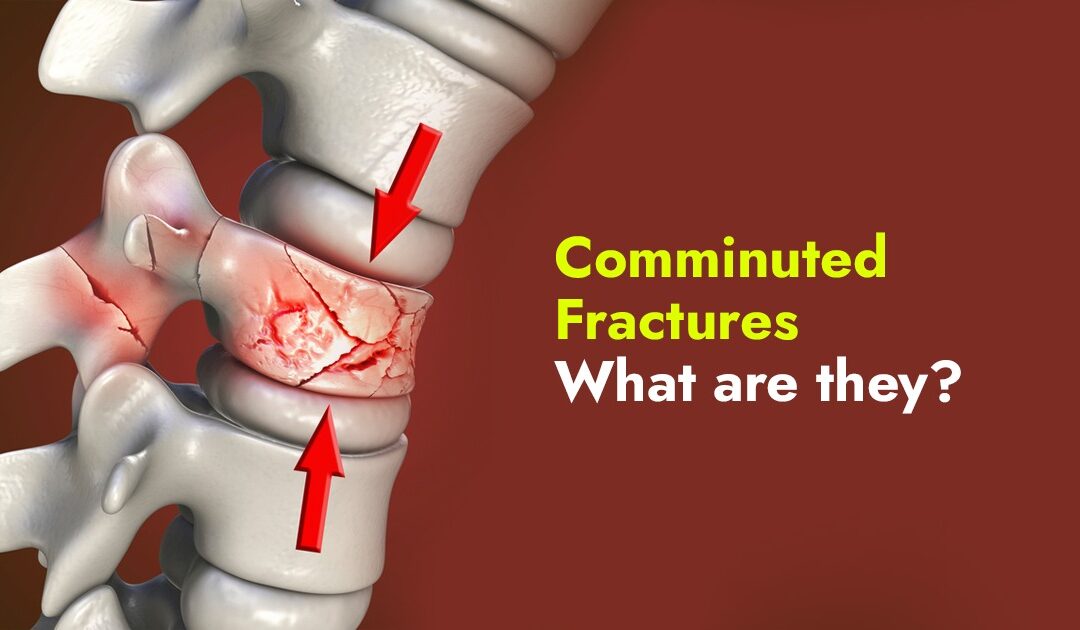Three or more broken bones are called comminuted fractures. A highly comminuted bone has more than four broken points. Comminuted fractures are complete bone fractures, unlike greenstick fractures, which crack but do not separate. So, Comminuted fractures in the long bones of the upper and lower extremities typically result in pain and restricted mobility.
Comminuted Fractures
Depending on the fracture location, tissue or organs may be damaged. If bone fragments penetrate the pleural space of the lung, a comminuted rib fracture can cause a pneumothorax. Comminuted extremity fractures can cause internal bleeding, which increases muscle pressure and causes compartment syndrome, a painful condition. This can kill surrounding tissue if left untreated, requiring immediate medical attention.
Symptoms of Comminuted Fracture
The trauma resulting in a comminuted fracture is likely to produce significant symptoms. Symptoms depend on other injuries. In general, comminuted fracture symptoms include:
- Extreme pain.
- Having trouble moving a body part.
- Some parts of your body look odd.
- Seeing bone through skin.
- Swelling.
- Bruising.
What Causes Comminuted Fractures?
Trauma causes comminuted fractures. Car accidents and falls from ladders or roofs are common causes. Any bone impact can cause a comminuted fracture. Slips, falls, and other common bone breaks rarely cause comminuted fractures.
Open vs. Closed Comminuted Fractures
Your Dallas pain medicine doctors will classify your fracture as open or closed. Open fractures break bone through skin. Some call open fractures compound fractures. Open fractures heal slower and are more prone to infections. Displaced or nondisplaced are other fracture terms your doctor may use.A displaced fracture transpires when bone fragments shift sufficiently to create a gap surrounding the fracture. Although non-displaced fractures are broken bones, the pieces were not misaligned. Surgery is needed more often for displaced fractures. Comminuted fractures always have multiple broken pieces, making them more likely to be displaced.
Diagnosing Comminuted Fractures
Tests or scans will help your doctor diagnose comminuted fractures.
- X-rays: This test photographs your bones and other body parts with energy beams. White areas represent your bones. A fractured bone will appear darker on an X-ray.
- MRI: These scans take pictures of your inner body from the outside using a large magnet and a computer. A computer monitor will assist your physician in identifying fractures within these images.
- CT scan: Your doctor may create horizontal and vertical body images with this scan. Details are greater than in regular X-rays.
Treatments for Comminuted Fractures
Your care depends on age, health, injury severity, treatment tolerance, and preference. No matter the treatment, the goal is to heal the injury, control pain, avoid complications, and restore function. Your treatment may include:
- Medication: You may need painkillers.
- Splint/Cast: After surgery, a splint or cast will immobilize your injured area. This promotes bone healing.
- Traction: Stretching your muscles and tendons around the broken bone may require a pulley, string, weight, or metal frame. This will keep your bone ends in place and heal properly. An open fracture necessitates distinct treatment compared to a closed fracture. Since the fracture broke your skin, bacteria and toxins may have entered. Your doctor will clean your broken skin, tissues, and bones to prevent infection.
Surgery can repair the bone and ensure it heals well so you don’t lose arm or leg function. Doctors may perform these surgeries on comminuted fractures:
- Internal fixation: To repair the bone, the doctor opens an area near the break. They’ll use rods, plates, screws, pins, and wires to hold the bones together while they heal.
- External fixation: For complex injuries not ready for surgery, a doctor may insert screws into fractured bones and attach them to a brace. This device holds screws while the bone and other internal injuries heal.
- Bone grafting: A doctor may use tissue from another bone, a donor, or artificial materials to replace badly damaged bone that can’t be repaired. They may also use internal fixation to hold your bones together while they heal and grow.
- To prevent bone movement while healing, you’ll need a cast, brace, or splint. If your injury is severe, you may need to wear this for months.
How to Repair Comminuted Fracture?
Comminuted fractures are diagnosed by physical examination and imaging, such as an x-ray, before repair. The type and bone of a comminuted fracture determine its repair. However, most need surgery. Surgery usually involves open reduction and internal bone fixation with screws and rods. Splints or casts are worn for weeks to months after surgery to reduce bone mobility. Muscle strength around the fracture is often improved by physical therapy.
Segmental Vs. Comminuted Fractures
Comminuted and segmental bone fractures are serious. They describe how, where, and how your bones are broken to your doctor. Comminuted fractures involve multiple broken bones. Comminuted fractures caused by trauma are usually shatter-like. Plates never break evenly when dropped. Same with most comminuted fractures.
Segmental fractures arise when a bone is fractured at two distinct locations, resulting in the detachment of a segment. Not all segmental fractures are comminuted. Getting your fracture examined by a doctor is the most important step, regardless of the name. Either a comminuted or segmental fracture is a serious injury, and only the best doctor like Dr William Moore Dallas can determine your treatment needs.
Conclusion
Comminuted fractures are three-piece bone breaks and treatment usually involves surgery and rest. If seriously injured and experiencing sudden, intense pain anywhere in your body, especially your arms or legs, seek medical help immediately.
